Warszawa II (30 page)
Authors: Norbert Bacyk
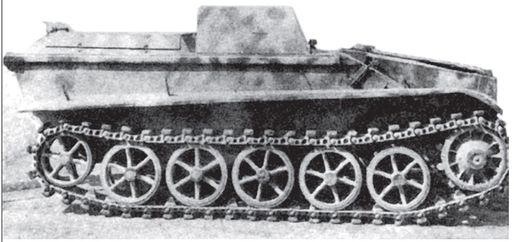
The Goliath's big brother. In contrast to the Goliath, which was a radio steered vehicle, the B IV was a “true” motor vehicle in the sense that it was controlled by a lone driver within the vehicle and could be used repeatedly. Around 500 were built during the war. In the Battle of Berlin, in 1945, they were used as improvised tank killers or “Jagdpanzers” with specially mounted Panzerschrecktuber (particularly large gun-barrels).
Production period:
1939 â 1945
Manufacturer:
Hansa-Loyd, Borgward
Tonnage:
3.66 tonnes
Crew:
1
Length:
3.65 meters
Width:
1.80 meter
Height:
1.19 meter
Track width:
- cm
Ground clearance:
- cm
Motor:
Borgward 6-cylinders Bensin
Engine capacity:
49 HP at 3500 rpm
Fuel capacity:
- liter
Maximum speed:
38 km/h
Maximum range:
210 km
Armament:
1 X 500 kg high explosives
Hull armour strength:
Maximum 10 mm
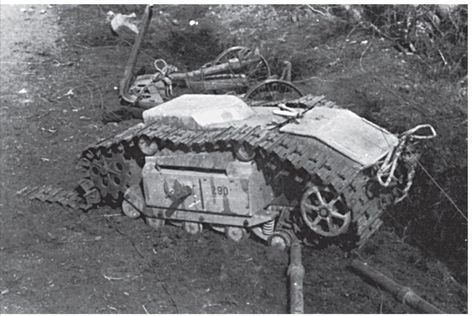
A so called “mini-tank” which carried high explosive charges weighing 100 kgs. Steered by a radio-control operator to a given target where the charge was then detonated: A so-called “disposable” weapon â fire once and forget â extremely effective if the enemy couldn't stop it. Not surprisingly, the armour was so weak that it could be pierced by small arms fire. Approximately 4,500 were built in total.
Production period:
1941 â 1945
Manufacturer:
Zundapp
Tonnage:
0.4 tonnes
Crew:
0
Length:
1.63 meters
Width:
0.91 meter
Height:
0.62 meter
Track width:
- cm
Ground clearance:
- cm
Motor:
Zundapp 2-cylinder Bensin
Engine capacity:
12.5HP at 4500rpm
Fuel capacity:
- liter
Maximum speed:
12 km/h
Maximum range:
12 km
Armament:
100kg high explosive charge
Armour strength:
0
Model D 7p, Sd Kfz 250/1 â 12, 252, 253
Mittlerer Schutzen-Panzerwagen
Model HL kl 6p and H kl 6 Sd Kfz 251/1 - 23
Â
Germany was the only warring nation during WWII which had two competing versions of half-track carriers tasked for troop transportation. Model 250 was the smaller version, 251 was the larger one. Both were produced in a large number of different versions used for specific purposes. The most common variations were the 250/1 infantry transport vehicle, the 250/3 radio carrier, the 250/4 artillery observation vehicle, the 250/7 8 cm mortar carrier. The 250's troop transport capacity, however, was inadequate; other than the two-man crew, only four men could be carried in a 250, whereas the 251 could carry ten men (i.e. an entire squad) in addition to its two-man crew. The model-250 was, in other words, too small. In addition, both models had under-powered engines, lacked roof protection and, in general, were far too poorly protected for operations on the frontline. There was, however, no other alternative available for the German Army and, in any event, they were never produced in quantities sufficient to cover their need. All told, approximately 7,500 model-250's of all variations were produced, and approximately 16,000 model-251's including all variations.
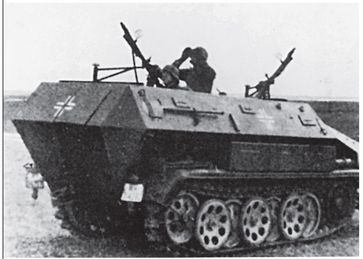
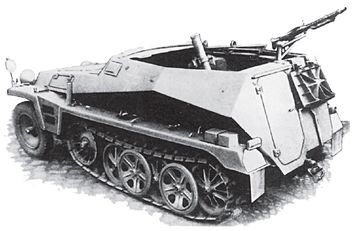
The following variations were built:
250/1
Armoured light transport carrier. Crew: 2 + 4 men.
250/2
Armoured combat command vehicle equipped with field telephone. Crew: 2 + 2 men.
250/3
Armoured radio carrier. Crew: 2 + 3 men.
250/4
Armoured firing direction carrier for artillery. Crew: 2 + 3.
250/5
Armoured light reconnaissance carrier.
Crew: 2 + 3 men.
250/6
Armoured ammunition transport carrier. Crew: 2
250/7
Armoured 8 cm mortar carrier. Crew: 2 + 3 men.
250/8
Armoured assault-gun carrier m 7.5 cm KwK 37 L/24. Crew: 2 + 3 men.
250/9
Armoured panzer reconnaissance carrier m 2 cm automatic gun Kwk 38/L55 in turret. Crew: 2 + 1 man.
250/10
Armoured light Pv-carrier m 3.7 cm PAK 35/36 L/45. Crew 2 + 2 men.
250/11
Armoured light Pv- vehicle, m 2.8 cm sPzB 41. Crew: 2 + 2 men.
250/12
Armoured firing direction carrier for range finding for artillery. Crew: 2 + 2 men.
252
Armoured light ammunition transport carrier with roof. Crew: 2 men.
253
Armoured light firing direction carrier for artillery with roof. Crew: 2 + 2 men.
Production period:
1939 â 1945
Manufacturer:
Demag
Tonnage:
5.7 tonnes
Crew:
2 + 4
Length:
4.65 meters
Width:
1.95 meters
Height:
1.66 meters
Track width:
24 cm
Ground clearance:
28 cm
Motor:
Maybach HL 42 TRKM V-6 Petrol
Motor capacity:
100 HP at 2000 rpm
Fuel capacity:
140 liters
Maximum speed:
65 km/h
Maximum range:
250 km
Armament:
1 â 2 Ã 7.92 mm MG
Ammunition quantity:
7.92 mm â 1000 â 2000 rounds
Armour strength:
Hull frontal:
10 â 15 mm
Hull sides:
8 mm
Hull rear, roof, floor:
8 mm
Turret front:
10 -15 mm (250/9)
Turret sides:
8 mm (250/9)
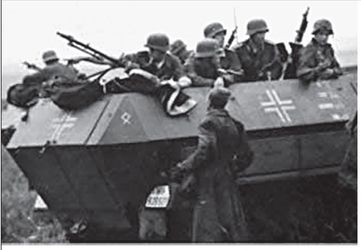
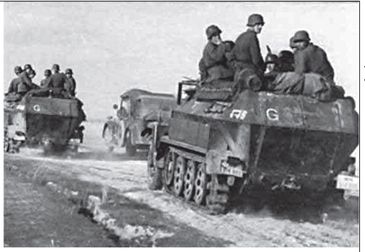
The following variations were built:
251/1
Armoured medium troop transport carrier. Crew: 2 + 10 men.
251/1
(Wuhrfrahmen) Armoured medium troop transport carrier with m 28/32 cm rocket launchers “Stuks zu Fuss”. Crew: 2 + 5 men.
251/2
Armoured 8 cm mortar carrier. Crew 2 + 4 men.
251/3
Armoured radio carrier. Crew 2 + 5 men.
251/4
Armoured artillery tractor. Crew 2 + 5 men.
251/5
Armoured transport carrier for pioneers(engineering troops/sappers). Crew 2 + 7 men.
251/6
Armoured command carrier for divisional, corp and Armeé commanders. Crew: 2 + 4.
251/7
Armoured transport carrier for assault engineers. Crew: 2 + 5 men.
251/8
Armoured ambulance. Crew 2 + 1.
251/9
Armoured assault-gun carrier 7.5 cm “Stummel”. Crew: 2 + 3 men.
251/10
Armoured platoon weapon support carrier 3.7 cm PAK. Crew: 2 + 3 men.
251/11
Armoured Field Telephone carrier. Crew: 2 + 3 men.
251/12
Armoured battery command carrier. Crew: 2 + 4 men.
251/13
Armoured fire direction carrier for artillery. Crew 2 + 4 men.
251/14
Armoured command carrier for artillery sound measurement. Crew: 2 + 6 men.
251/15
Armoured command carrier for observation of artillery firing. Crew 2 + 4.
251/16
Armoured flamethrower “Flamenwerfer 40”. Crew 2 + 3 men.
251/17
Armoured anti-aircraft gun carrier Flak 38 2 cm. Crew 2 + 4 men.
251/18
Armoured battle command carrier. Crew 2 + 4 men.
251/19
Armoured command carrier with telephone exchange. Crew 2 + 4 men.
251/20
Armoured carrier for search light “Uhu”. Crew 2 + 2 men.
251/21
Armoured anti-aircraft gun carrier MG 151/15 “drilling”. Crew 2 + 4 men.
251/22
Armoured Pv â carrier PAK 40 7.5 cm. Crew 2 + 2 men.
251/23
Armoured reconnaissance carrier 2 cm Kwk 38. Crew 2 + 2.
Production period:
1939 â 1945.
Manufacturer:
Hanomag and Borgward
Tonnage:
8.5 tonnes
Crew:
2 + 10 (see above)
Length:
5.80 meters
Width:
2 meters
Height:
1.75 meter
Track width:
28 cm
Ground clearance:
32 cm
Motor:
Maybach HL 42 TUKRM V-6 Bensin
Engine capacity:
100 HP at 3000rpm
Fuel capacity:
160 liters
Maximum speed:
53 km/h
Maximum range:
320 km
Armament:
1 â 2 Ã 7.92 mm MG, depending on model.
Ammunition quantity:
7.92 mm.
Between 1200 and 3600 rounds depending on model.
Armour strength:
Hull frontal:
12 mm
Hull sides:
8 mm
Hull rear, roof, floor:
8 mm
Turret front:
12 mm
Turret sides:
8 mm